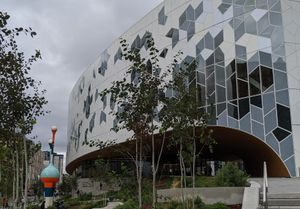Two trends: centripetal and centrifugal
Think of two trends in the development of the library’s network presence. These have emerged successively and continue to operate together.
- A centripetal trend producing a library network presence centered on the institutional website, as the library wants to offer an integrated service.
- A centrifugal trend, unbundling functionality and placing it in a variety of decentered network presences, as the library wants to be in the flow of its users (think of how communication has been unbundled to social networking sites for example, or of how metadata may be shared with various aggregation sites, or of how a resolver may be configured for use with a third party site).
The decentered library network presence is an important component of library service although it still appears to be an emergent interest in strategic or organizational terms.
In the centripetal trend, the focus was on integration around a singular, ‘centered‘ network presence: the library website. The library website was the principal de facto network manifestation of the library, and the integration of library services in the website was a goal. Early examples of this were discussions around ‘portals’, one-stop-shops and metasearch. Later, this trend continued with more consolidated approaches which overcame some of the cost and inefficiencies of integration. Included here were the use of unified search systems often deploying integrated discovery layer products, the use of resource guides to manage resources with a consistent approach, the adoption of content management systems. Service consolidation, a stronger focus on providing a coherent user experience, a move to cloudsourced applications (discovery and resource guides for example), and an emerging emphasis on full library discovery help create a more unified experience at the library website.
In the centrifugal trend, the network library presence is decentered, unbundled or decoupled to an evolving ecosystem of services, each with a particular focus or scope. Think for example of how aspects of user engagement have been unbundled to various social networking sites (Facebook, Twitter, Pinterest, Flickr, …), or of how parts of the discovery experience has been unbundled to Google Scholar or PubMed or to a cloud-based discovery layer, or of how some library services are atomized and delivered as mobile apps, toolbar applications, or ‘widgets’ in learning management systems and other web environments external to the library’s. The library website is now a part, albeit an important part, of this evolving network presence. In this way, the library network presence has been decentered, subject to a centrifugal trend to multiple network locations potentially closer to user workflows. There are two important drivers here. One is the desire to reach into user workflows, acknowledging that potential library users may not always come to the library website. A second is the desire to make institutional resources (digitized special collections, research and learning materials, for example) available to external audiences in more effective ways. This is an aspect of the ‘inside-out library‘.
A decentered library network presence.
Here are some strands of the ‘decentered’ library network presence.
- Unbundled engagement and communication. Several activities may have been decoupled from the website and sourced with web-scale services. For example, engagement and communications activities may be sourced with Twitter, Facebook, and WordPress. Promotional activity may take place on YouTube, Flickr, and Pinterest.
- Syndication: We can define syndication as creating connections to library information services in other environments, by placing data, content or services in those other environments. Library resources may be made available, for example, as widgets in the learning management system, as an RSS feed, or in a LibX-style toolbar. There is also strong interest in apps for mobile phone and tablets. The library may syndicate data to other environments, passively through OAI-PMH harvesting or newer linked data approaches, or by more active transfers to WorldCat or some other metadata aggregation. The library may configure a resolver to ensure well-seamed access from Google Scholar or Pubmed Central, which is also a form of service syndication. The goal is to make the library resources discoverable in user workflows. The University of Minnesota discoverability reports are well worth reading in this context.
- Cloudsourcing: Integration of systems and services, sourced from the cloud. It is now becoming more common to externalise systems provision to third party providers: think of the discovery layers that libraries are deploying in the cloud for example, or the LibGuides resource guides. The move to cloud providers is a major direction here, and one of the motivations is to reduce some of the systems integration complexity, while improving the user experience. By cloudsourcing here, I am referring to the selective move of library operations to the cloud. Of course, the unbundled communication activity is also sourced from the cloud, but is typically from non-library providers. As noted above, cloudsourcing can support the centripetal trend as external resources may be integrated in the website, but it also supports the centrifugal trend as services may be made available as independent external destinations, or may be syndicated to other network presences (e.g. access to a central index API).
Now, despite the fact that there is quite a bit of activity supporting what I am calling here the decentered network presence, it has not crystallized as a service or organizational category for the library. It is an area of emergent interest. There seem to be at least three factors at play.
- Unquantified. Libraries don’t have a holistic view of traffic against their entire network presence. The difficulty of compiling statistics across services is well known. Libraries are working across multiple environments and systems, with intermittent availability of good data about usage, no consistent approach across systems, and usually no aggregate view. This means that the library’s knowledge of the use of its own services, and of the benefits of particular approaches, is limited in important ways. At the same time, while there is awareness of the benefits of better data, a data-driven approach to engagement, resource allocation, or service development is not yet prevalent. Anecdotal and local evidence shows the importance of syndicated approaches (including Google referrals) in general traffic against library resources, but we do not have a general picture.
- Pre-strategic. The importance of unbundled communication, syndication and cloudsourcing is agreed. However, strategic attention to these areas is often rather more emergent than deliberate (in the sense in which Mintzberg uses these terms). Attention may be opportunistic, although is likely to be increasingly patterned in future.
- Spanning organizational boundaries. A variety of parts of the library is interested in a network presence, and attention to these topics may not always be pulled together in a single planning context. This is clear of social networking, but may also be the case with the other areas I mention.
Clearly, there are different dynamics at play in the components of the decentered network presence of the library. However, we can expect a more holistic view to emerge in coming years.
Related entries:
- Full library discovery
- Discovery vs discoverability
- There is more to discovery than you think
- Outside-in and inside-out redux
Picture: I took the feature image in Kettle's Yard, in Cambridge, UK.
Note: Cosmetic updates on transition to new site on 30 March 2021, including spacing and addition of headings.




